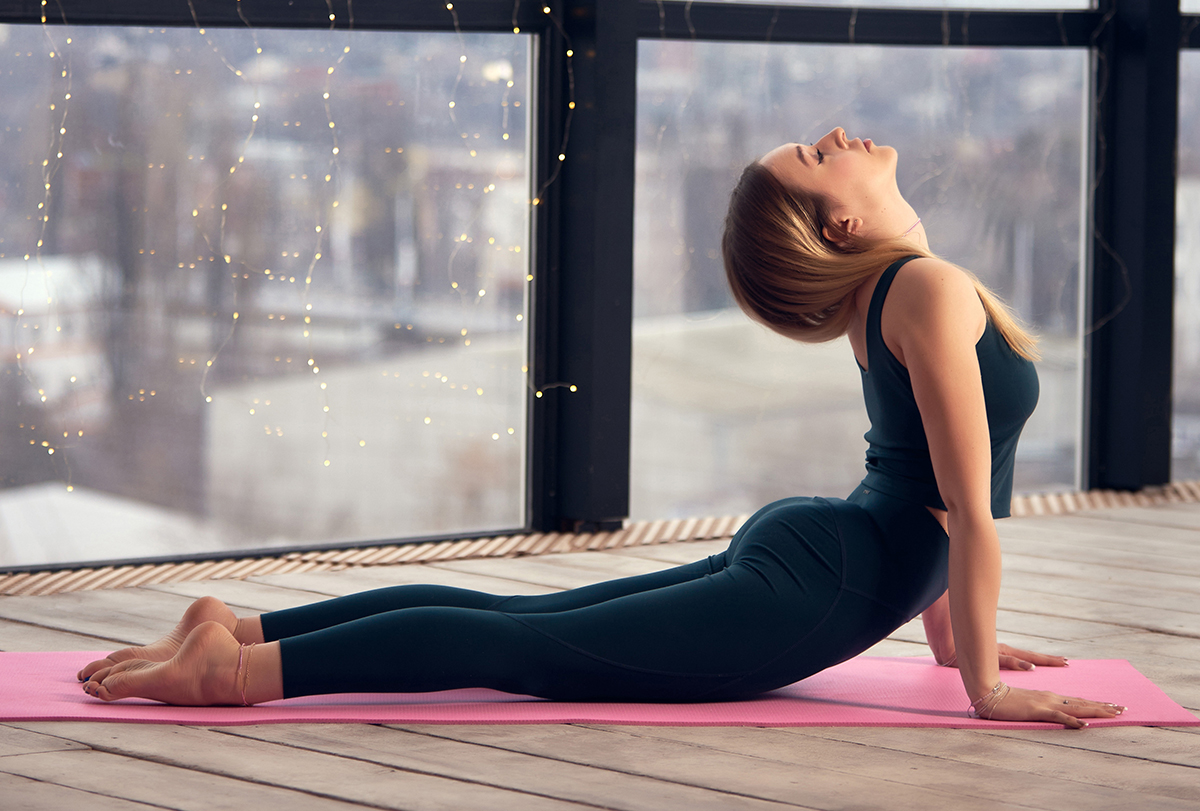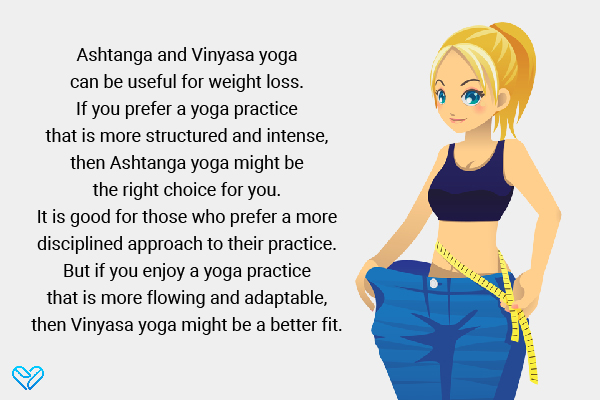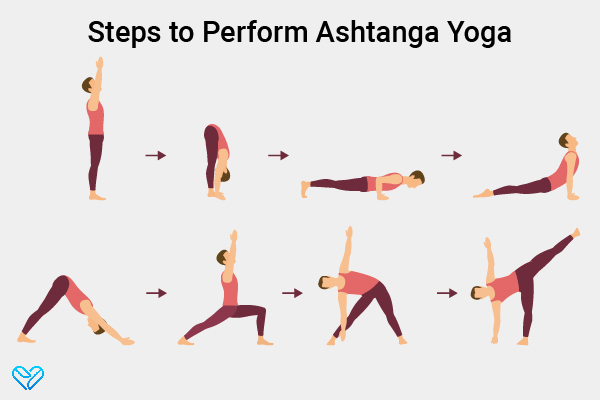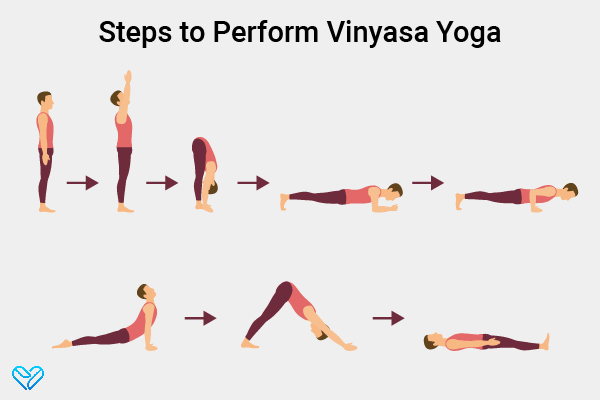In this article:
Obesity and being overweight can cause a lot of health issues. Nowadays, more and more people are turning to yoga, specifically Ashtanga and Vinyasa, to help with weight loss. These types of yoga involve a series of poses (asanas) that flow together smoothly.

Ashtanga yoga is more structured and intense. It follows a set sequence of poses practiced in the same way all over the world. This is the most pronounced thing about it – how universal it is. Plus, it’s great for weight loss, building muscles, and improving physical fitness.
Vinyasa yoga, on the other hand, is more flexible and freestyle. It focuses on coordinating your breath with different poses. It can also help burn calories and build strength, but it’s usually easier for beginners because it’s less intense.
While both forms of yoga offer numerous health benefits, including weight loss, improved flexibility, and strength, the main difference between the two is the level of flexibility and intensity. (1)(2) Vinyasa tends to be more flexible and is more suitable for novices.
This article will elaborate on which style is better for you.
Ashtanga Versus Vinyasa: How They Work for Weight Loss
When it comes to weight loss, both Ashtanga and Vinyasa yoga can be useful. You may choose what works best for you based on your personal preferences and fitness goals.
Vinyasa yoga focuses on maintaining powerful poses and building muscular endurance. Research suggests that Vinyasa yoga can have a similar metabolic intensity to moderate-intensity walking, meaning it burns a similar amount of calories, making it a good choice for weight loss. (2)
On the other hand, researchers have found that an Ashtanga yoga program could help people achieve positive changes in their height, weight, BMI, body measurements, and skinfold thickness. (1)
So, if you prefer a yoga practice that is more structured and intense, then Ashtanga yoga might be the right choice for you. It is good for those who prefer a more disciplined approach to their practice.
But if you enjoy a yoga practice that is more flowing and adaptable, then Vinyasa yoga might be a better fit. It permits more creativity and liberty in the sequence of poses.

Ashtanga yoga and weight loss
Here are some scientific studies that support the performance of Ashtanga yoga for weight loss and management.
1. Ashtanga yoga for weight loss in children and adolescents
Ashtanga yoga has been shown to be a safe and effective intervention for weight management and psychological well-being.
In one study, participants aged 8–15 attended a 12-week Ashtanga yoga practice, which comprised two weekly 90-min sessions.
The outcomes demonstrated a noted reduction in people’s BMI, with an average reduction of 1.4 points. There was also a considerable improvement in the participant’s psychological well-being including reduced symptoms of anxiety and upliftment in self-esteem. (3)
2. Ashtanga yoga better for weight management than general yoga
Another study suggests that Ashtanga yoga may be more effective than general yoga for weight management and improving quality of life in individuals with abdominal obesity.
The outcomes indicated a substantial decrease in weight, abdomen circumference, and BMI in both groups. However, the reduction was greater in the Ashtanga yoga group compared to the general yoga group. (1)
Vinyasa yoga and weight loss
Effective at-home weight loss strategy
Vinyasa yoga is the ideal choice for those who prefer something more intentional and at home than doing exercises in the gym. Studies have found it to be comparable to other moderate-intensity exercises such as walking or cycling.
In the study, a 60-minute Vinyasa yoga session that included sun salutations, standing postures, seated postures, backbends, and inversions resulted in an average energy expenditure of 225.2 calories for males and 171.3 calories for females. (4)
Another research showed that while there was no significant difference in energy expenditure between Vinyasa yoga and walking, the higher heart rate during the Vinyasa yoga session suggests that it may be a more intense form of exercise.
This means Vinyasa yoga may be beneficial for not only weight loss but also cardiovascular health. (5)
What to choose?
Scientific studies have shown that Ashtanga yoga can be beneficial for weight management and psychological well-being in children and adults, whereas Vinyasa yoga can be an effective way to expend energy and improve vascular function, lipid and glucose concentrations, and mood.
Ultimately, the most important factor in weight loss is consistency, so it is important to choose a style of yoga that you enjoy and can commit to practicing it regularly. (3)(4)(6)
How to Perform Ashtanga Yoga
Here are the steps to perform Ashtanga yoga.

Start with the first sequence:
- Begin in tadasana (mountain pose). Breathe in and put your arms overhead. Breathe out and move onto uttanasana (forward bend).
- Breathe in and lift halfway up. Exhale and get into chaturanga dandasana (four-limbed staff pose).
- Inhale and roll over your toes into urdhva mukha svanasana (upward-facing dog).
- Breathe out and bring your hips upwards into adho mukha svanasana (downward-facing dog).
Move on to the next sequence:
- Tadasana
- Uttanasana
- Chaturanga dandasana
- Urdhva mukha svanasana
- Adho mukha svanasana
- Warrior pose
- Trikonasana (triangle pose)
- Ardha chandrasana (half-moon pose).
- Repeat this sequence on the other side.
Move on to the standing sequence:
This sequence includes:
- Prasarita padottanasana (wide-legged forward fold)
- Parsvottanasana (pyramid pose)
- Utthita hasta padangusthasana (extended hand-to-big-toe pose)
Move on to the seated sequence:
This sequence includes:
- Dandasana (staff pose)
- Janu sirsasana (head-to-knee forward bend)
- Paschimottanasana (seated forward bend)
Move through this sequence on both sides.
End with the finishing sequence:
This sequence includes:
- Salamba sarvangasana (supported shoulderstand)
- Matsyasana (fish pose)
- Finish with savasana (corpse pose) to relax.
It’s important to note that Ashtanga yoga is a physically challenging practice, and it’s recommended to learn from a qualified teacher to ensure proper alignment and safety.
How to Perform Vinyasa Yoga
Here are the steps to perform Vinyasa yoga:

- Begin in tadasana (mountain pose).
- Breathe in and put your arms up your head.
- Exhale and fold forward with your knees slightly bent.
- As you inhale, lift your torso up halfway.
- Exhale and get back into the plank pose.
- Get into chaturanga dandasana.
- Inhale and get into an upward-facing dog.
- Exhale and get into a downward-facing dog.
- End with savasana (corpse pose).
Keep in mind to be comfortable and modify the poses as needed. Vinyasa yoga can be a dynamic and physically demanding practice, so it’s important to learn from a qualified teacher and to practice with proper alignment and safety to avoid the risk of injuries.
More on Ashtanga Yoga
Ashtanga yoga is a traditional style of yoga that originated in India and draws inspiration from the teachings of Patanjali’s Yoga Sutras. It was made famous by Sri K. Pattabhi Jois, an Indian yoga teacher, in the 20th century.
Ashtanga yoga involves a set of poses that are performed in a specific order, and each pose is kept up for a few breaths before moving on to the next pose. The practice is physically demanding, and practitioners often work up a sweat as they move through the sequence of poses.
Studies show regular Ashtanga yoga practice may contribute to well-being across multiple dimensions – the physical, psychological, social, spiritual, and environmental dimensions of well-being.
Participants described feeling more physically fit, energized, and balanced, as well as experiencing reduced stress, anxiety, and depression. (7)
Participants also reported feeling more connected to their community and the natural environment and experiencing a sense of purpose and meaning in life. (7)
More on Vinyasa Yoga
Vinyasa yoga is a popular style of yoga that concentrates on linking movement with breathing to create a continuous sequence of poses.
A study showed that Vinyasa yoga, also known as Vinyasa flow yoga, can have acute effects on vascular function, lipid and glucose concentrations, and mood.
Results showed that a single session of Vinyasa flow yoga significantly improved vascular function and lowered blood pressure. Additionally, the participants had lower amounts of triglycerides and total cholesterol after the class. Finally, the participants reported improvements in mood. (6)
Most-Asked Questions
Is Vinyasa yoga suitable for beginners?
Yes, Vinyasa yoga can be suitable for beginners, but it’s important to start with a beginner-level class and to learn proper alignment and modifications from a qualified teacher.
Is it necessary to practice both Vinyasa and Ashtanga yoga?
No, it’s not necessary to practice both Vinyasa and Ashtanga yoga. You can choose a style that works best for you.
Final Word
Both Ashtanga and Vinyasa yoga can be effective for weight loss, and the choice of style depends on individual preferences and fitness goals.
Ultimately, the most important factor in weight loss is consistency, and choosing a yoga style that is enjoyable and sustainable can contribute to a successful weight loss journey.
- Was this article helpful?
- YES, THANKS!NOT REALLY


